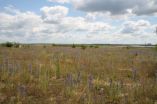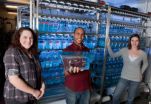(Press-News.org) How do ecosystems develop? No one really knows, yet. There is however one project, unique in the world, seeking to answer this question. In a former open-pit coal mining area in Brandenburg, Germany, a surface of six hectares was partitioned off and then left to its own resources. Scientists from the Technische Universitaet Muenchen (TUM), in collaboration with researchers from other institutions, are studying the development of soil, flora, and fauna there. With this research they aim to establish the factors that have a particularly strong influence on developing ecosystems.
Young ecosystems are rare. They can be found, for instance, when ice from thawing glaciers releases the pristine debris it transports -- as is currently the case with the Damma Glacier in the Swiss Alps. In general, though, we are surrounded by age-old ecosystems that have developed over millions of years and whose interactions and structures are well established. Such systems are, for instance, rain forests, deserts, or seas. Scientists do not know much yet about how these systems develop. The geochemical and biological processes that occur during development are for the most part well understood. It is not yet clear, though, how and when they occur and what influences them. In order to unveil nature's secrets, scientists from TUM are participating in an international interdisciplinary project.
To this end, BTU Cottbus constructed a special research area, unique in the world. It is located in a former open-pit coal mining region south of Cottbus and bears the name of a creek that used to flow through there: Huehnerwasser, or Chicken Creek. Regional sediment originating from the ice age was re-deposited, graded, and fenced off over an area larger than six football fields. A protective layer of clay was laid out at a depth of several meters to capture percolating rainwater and direct it toward an artificial spring flowing into a pond. No fertilizer was used, not a single seed planted, no organism artificially cultivated there. Since its completion in the fall of 2005, the world's largest artificial water catchment area has been developing autonomously. It is being meticulously observed, though. As if in an open air laboratory, the BTU Cottbus, the ETH Zurich, and other non-academic partners have been conducting research together with the Technische Universitaet Muenchen on this project since 2007.
TUM researchers are looking into this area from various perspectives. Plant ecologists checked the initial state of the seed reservoir in the soil and are now observing the development of the vegetation, i.e. which plant species settle in the soil, in what order, and where their seeds come from. Forest growth researchers are studying the surface structures. For instance, they regularly measure the changes in soil surface and vegetation. Their goal is to generate a mathematical model that can simulate the dynamic interaction between vegetation and surface development. Soil ecologists look into the soil. They analyze time and again the number and species of microorganisms living in the soil to establish how, over the years, complex microbial communities develop in the soil at Chicken Creek, and why their composition and activity change as the seasons pass.
Professor Ingrid Koegel-Knabner and her team from the TUM Chair for Soil Science are investigating soil development from a different perspective. Their research focuses primarily on humus formation, i.e. the transformation of dead plant material into valuable, nutrient-rich soil. The researchers regularly examine the composition of soil samples in order to study the processes taking place during this initial humus formation stage. Initial results are surprising – soil development and plant colonization at Chicken Creek are progressing more rapidly than originally assumed. "After only five years we see the first trees -- robinias," Koegel-Knabner marvels. "We weren't expecting that in under 20 years. This probably also means that a forest will grow more quickly than expected."
The most important hypothesis of the project is that the starting phase of an ecosystem is decisive. Ingrid Koegel-Knabner: "We don't know yet how long this initial phase takes. But we assume that it influences the entire subsequent development and, therefore, defines the later ecosystem at the outset." Yet what are the prevalent factors that influence the initial phase? It has already become clear that rain is one of these factors. At the very beginning a cloudburst created furrows at the site of the experiment, where water had run off and washed away the soil. The next rain also ran off through these furrows -- they became deeper and wider. That is how the first downpour determined the subsequent course of water flow and thus the locations of the plants.
What other factors play a role in the development could become clear within just a few years. The project is set to run over twelve years altogether. This might sound like a relatively long time; however, in the development time scale of an ecosystem this is practically one instant. Nevertheless, the scientists hope to gain fundamental insights into the initial stages of ecosystem development, which can later be used for targeted intervention into man-made landscapes -- for their re-naturation or re-cultivation.
INFORMATION:
Contact:
Prof. Dr. Ingrid Koegel-Knabner
Chair for Soil Science
Technische Universitaet Muenchen
85350 Freising-Weihenstephan
Tel.: 08161 / 71-5174
E-Mail: koegel@wzw.tum.de
http://www.wzw.tum.de/bk/index.html
Free images to download:
http://mediatum.ub.tum.de/?id=1004737
Literature:
Fischer T., Veste M., Schaaf W., Duemig A., Koegel-Knabner I., Wiehe W., Bens O. and Huettl R.F.: Initial pedogenesis in a topsoil crust 3 years after construction of an artificial catchment in Brandenburg, NE Germany. Biogeochemistry, 2010, Online-Vorabveroeffentlichung. doi: 10.1007/s10533-010-9464-z
Gerwin W., Schaaf W., Biemelt D., Fischer A., Winter S., Huettl R.F.: The artificial catchment "Chicken Creek" (Lusatia, Germany) - A landscape laboratory for interdisciplinary studies of initial ecosystem development. – Ecological Engineering 35, 2009, 1786-1096. doi: 10.1016/j.ecoleng.2009.09.003
Pretzsch H. und Biber P.: Size-symmetric versus size-asymmetric competition and growth partitioning among trees in forest stands along an ecological gradient in central Europe. Canadian Journal of Forest Research 40, 2010, 370-384. doi: 10.1139/X09-195
Background:
The Collaborative Research Project/Transregio 38 "Structures and processes of initial ecosystem development in an artificial water catchment area" is funded by the German Research Foundation (DFG). The project is being funded with around 4.5 million Euros for the first four years, 1.3 million of which supports research at the TUM. Further information on the project as well as videos, an image gallery and related links can be found at http://www.dfg-science-tv.de/de/projekte/natur-am-start
Technische Universitaet Muenchen (TUM) is one of Europe's leading technical universities. It has roughly 460 professors, 7,500 academic and non-academic staff (including those at the university hospital "Rechts der Isar"), and 26,000 students. It focuses on the engineering sciences, natural sciences, life sciences, medicine, and economic sciences. After winning numerous awards, it was selected as an "Elite University" in 2006 by the Science Council (Wissenschaftsrat) and the German Research Foundation (DFG). The university's global network includes an outpost in Singapore. TUM is dedicated to the ideal of a top-level research based entrepreneurial university.
Fledgling ecosystem at Chicken Creek lets scientists observe how soil, flora and fauna develop
Unique open-air laboratory enables study of a complete ecosystem in the making
2010-12-07
ELSE PRESS RELEASES FROM THIS DATE:
Drug prevents post-traumatic stress syndrome
2010-12-07
CHICAGO --- Post-traumatic stress syndrome – when a severely stressful event triggers exaggerated and chronic fear – affects nearly 8 million people in the United States and is hard to treat. In a preclinical study, Northwestern Medicine scientists have for the first time identified the molecular cause of the debilitating condition and prevented it from occurring by injecting calming drugs into the brain within five hours of a traumatic event.
Northwestern researchers discovered the brain becomes overly stimulated after a traumatic event causes an ongoing, frenzied ...
Pure nanotube-type growth edges toward the possible
2010-12-07
New research at Rice University could ultimately show scientists the way to make batches of nanotubes of a single type.
A paper in the online journal Physical Review Letters unveils an elegant formula by Rice University physicist Boris Yakobson and his colleagues that defines the energy of a piece of graphene cut at any angle.
Yakobson, a professor in mechanical engineering and materials science and of chemistry, said this alone is significant because the way graphene handles energy depends upon the angle -- or chirality -- of its edge, and solving that process for ...
Early safety results promising for Phase I/II trial of gene therapy treatment of hemophilia B
2010-12-07
Investigators report no evidence of toxicity in the four hemophilia B patients enrolled to date in a gene therapy trial using a vector under development at St. Jude Children's Research Hospital and UCL (University College London) to correct the inherited bleeding disorder.
This trial was designed primarily as a safety test, with low and intermediate doses of the vector expected to produce little detectable Factor IX. The Factor IX protein helps the blood form clots. Individual with hemophilia B lack adequate levels of this clotting factor. The first participant in the ...
People with severe mental illness 12 times more likely to commit suicide
2010-12-07
People with psychotic disorders, such as schizophrenia or bipolar disorder, are 12 times more likely to commit suicide than average, according to research released today by King's Health Partners.
The research found that the rate of suicide was highest in the first year following diagnosis (12 times national average) and that high risk persisted – remaining four times greater than the general population ten years after diagnosis, a time when there may be less intense clinical monitoring of risk.
Neither the risk of suicide nor the long-term risk of suicide, as compared ...
Profiling based on mobile, online behavior: A privacy issue
2010-12-07
CORVALLIS, Ore. – It's illegal for businesses and law enforcement to profile a person based on their race, gender, or ethnicity, yet millions of Americans are being profiled every day based on their online consumer behavior and demographics.
Known as consumer profiling for behavioral advertising purposes, this type of profiling is largely unregulated.
The result, according to two recent articles in the journal of Computer Law & Security Review, is that consumers have less privacy and are being targeted by advertisers using increasingly sophisticated measures, which ...
The taster in your water line
2010-12-07
It is supposed to be cool, colorless, tasteless and odorless. It may not have any pathogens or impair your health. This is the reason why drinking water is put to a whole series of screenings at regular intervals. Now, the AquaBioTox project will be added to create a system for constant real-time drinking water monitoring. At present, the tests required by the German Drinking Water Ordinance are limited to random samples that often only provide findings after hours and are always attuned to specific substances. In contrast, the heart of the AquaBioTox system is a bio-sensor ...
Scientists find gene linked to congenital heart defect
2010-12-07
A gene that can cause congenital heart defects has been identified by a team of scientists, including a group from Princeton University. The discovery could lead to new treatments for those affected by the conditions brought on by the birth defect.
Princeton researchers focused on identifying and studying the gene in zebrafish embryos, and the team's work expanded to include collaborations with other groups studying the genetics of mice and people.
"This work really showcases the use of collaborative science and multiple model systems to better understand human disease," ...
Parkinson's drug could treat restless leg syndrome
2010-12-07
AUGUSTA, Ga. – A drug prescribed for Parkinson's disease may also treat restless leg syndrome without the adverse side effects of current therapies, Medical College of Georgia researchers say.
Rasagaline works by prolonging the effect of dopamine, a chemical that transmits signals between nerve cells in the brain. The cause of RLS is unknown, but research suggests a dopamine imbalance. Parkinson's is caused by a dopamine insufficiency.
"The hope is that Rasagaline, because it prolongs the effect of existing dopamine, instead of producing more, will not come with adverse ...
Mayo Clinic finds long-term prognosis is excellent for most children with seizures
2010-12-07
ROCHESTER, Minn. -- Mayo Clinic researchers studied more than 200 children with epilepsy and found that even if the cause of focal-onset seizures cannot be identified and they do not fit into a known epilepsy syndrome, long-term prognosis is still excellent. This study was presented at the American Epilepsy Society's (http://www.aesnet.org/) annual meeting in San Antonio on Dec. 4.
Epilepsy (http://www.mayoclinic.org/epilepsy/) is a disorder characterized by the occurrence of two or more seizures. It affects almost 3 million Americans, and approximately 45,000 children ...
Scientists announce discovery of first horned dinosaur from South Korea
2010-12-07
Cleveland - Scientists from South Korea, the United States and Japan analyzed fossil evidence found in South Korea and published research describing a new horned dinosaur. The newly identified genus, Koreaceratops hwaseongensis, lived about 103 million years ago during the late Early Cretaceous period. The specimen is the first ceratopsian dinosaur from the Korean peninsula. The partial skeleton includes a significant portion of the animal's backbone, hip bone, partial hind limbs and a nearly complete tail. Results from the analysis of the specimen were published in ...
LAST 30 PRESS RELEASES:
Study debunks myth of native Hawaiians causing bird extinctions
Tailored biochar could transform how crops grow, resist disease, and clean polluted soils
Biochar-based enzyme technology offers new path for cleaner water and soil
Biochar helps farmland soils withstand extreme rain and drought by steadying carbon loss
New study reveals major gaps in global forest maps
Ochsner Health names Dr. Timothy Riddell executive vice president and chief operating officer
Can future-focused thoughts help smokers quit?
From brain scans to alloys: Teaching AI to make sense of complex research data
Stem Cell Reports seeks early career editors to join the editorial board
Signs of ancient life turn up in an unexpected place
Pennington Biomedical researchers explore factors behind body’s ability to regulate weight
Zhongping Lee awarded the Nils Gunnar Jerlov Medal
Deborah S. Kelley awarded the Wallace S. Broecker Medal
Novel immunotherapy demonstrates early potential to overcome resistance to immune checkpoint therapy
LLM treatment advice agrees with physician recommendations in early-stage HCC, but falls short in late stage
Deep learning model trained with stage II colorectal cancer whole slide images identifies features associated with risk of recurrence – with higher success rate than clinical prognostic parameters
Aboard the International Space Station, viruses and bacteria show atypical interplay
Therapies that target specific type of cell death may be an effective avenue for cancer treatment, UTHealth Houston researchers find
CHEST releases guideline on biologic management in severe asthma
Scientists create a system for tracking underwater blackouts
Fruit fly pigmentation guides discovery of genes that control brain dopamine and sleep
World's largest physics conference to be held in Denver and online this March
New mega-analysis reveals why memory declines with age
Understanding ammonia energy’s tradeoffs around the world
UTHealth Houston researchers map gene disruptions in sporadic early onset Alzheimer’s disease across key brain regions
Minimum wage increases are linked to safer pregnancies
Left in the cold: Study finds most renters shut out of energy-saving upgrades
This crystal sings back: Illinois collaboration sheds light on magnetochiral instability
Organisms in the Atacama Desert soil are remarkably diverse
Children’s Hospital Colorado research outlines first pediatric classifications for suicide risk in adolescents and kids
[Press-News.org] Fledgling ecosystem at Chicken Creek lets scientists observe how soil, flora and fauna developUnique open-air laboratory enables study of a complete ecosystem in the making



